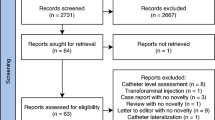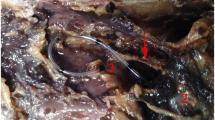Abstract
Background
The location of epidural space for local anaesthetic injection can be difficult. The aim of this study was to define the mathematical function of the pressure changes in the syringe during puncture of the epidural space. Knowledge of pressure changes might be of help to the anesthetist who attempts to ascertain the location of the needle, and it is essential to the design of a device with which to locate epidural space.
Methods
Epidural punctures were performed in 20 patients, using an 18-Tuohy needle connected to a 10 ml syringe. The epidural space was located by theloss of resistance technique. Pressure variations within the injection system during epidural puncture were measured and digitized at 250 Hz. Pressure curves were analyzed for amplitude and rate of a decay after entry of the needle into the epidural space.
Results
Pressure increased as the needle passed through skin, subcutaneous fat and muscle. The maximal pressure was observed when the needle perforated theligamentum flavum (689±124 cm H2O). When the needle entered the epidural space, an exponential decrease in pressure was observed in all patients (R2=0.99; τ=2.1±0.9 seconds). End-residual pressure was 22±12 cm H2O. The change in pressure observed when the needle entered the epidural space fitted a negative exponential function (y=e−x/2.08).
Conclusions
Pressures within the injection system for epidural puncture can reach 1100 cm H2O. Location of the epidural space is characterized by an exponential decay to and end-residual pressure below 50 cm H2O, with a constant time of approximately 2 seconds.
Similar content being viewed by others
References
Gutiérrez A. Anestesia metamérica peridural. Rev Cir Buenos Aires. 1932;12:665–671.
Dogliotti AM. Anaesthesia. Chicago, S. B. Debour, 1939.
Usubiaga JE, Wikinski JA, Usubiaga LJ. Epidural pressure and its relation to spread of anethetic solutions in epidural space. Anesth Analg 1967;46:440–447.
Bromage PR. Analgesia Epidural. Barcelona, Salvat Editores, S.A., 1984.
Galbert MW, Marx GF. Extradural pressures in parturient patients. Anesthesiology, 1974;40:499–504.
Usubiaga JE, Moya F, Usubiaga LJ. Effect of thoracic and abdominal pressure changes on the epidural space pressure. Br J Anesth 1967;39:612–615.
Author information
Authors and Affiliations
Rights and permissions
About this article
Cite this article
Rodiera, J., Calabuig, R., Aliaga, L. et al. Mathematical analysis of epidural space location. J Clin Monitor Comput 12, 213–217 (1995). https://doi.org/10.1007/BF01207201
Accepted:
Issue Date:
DOI: https://doi.org/10.1007/BF01207201




